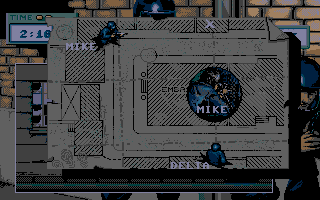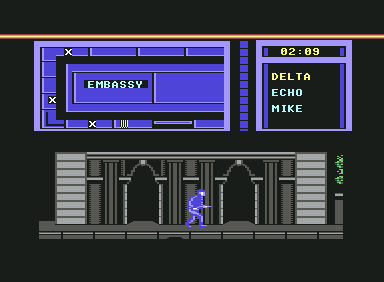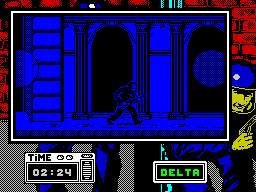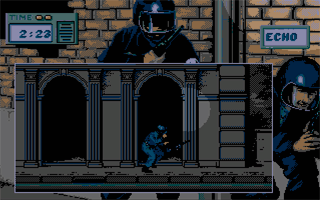Retro Replay Review
Gameplay
From the moment you pick up the controller, Hostage: Rescue Mission throws you into a tense, high-stakes operation that demands both precision and teamwork. The two-phase structure—first setting up snipers, then launching a full-scale assault—creates an engaging ebb and flow. Managing three sharpshooters to cover windows, rooftops, and choke points is a satisfying puzzle in itself, as you must anticipate enemy patrol routes and lines of sight. Successfully positioning your marksmen not only opens up new tactical options but directly influences the second phase’s difficulty.
(HEY YOU!! We hope you enjoy! We try not to run ads. So basically, this is a very expensive hobby running this site. Please consider joining us for updates, forums, and more. Network w/ us to make some cash or friends while retro gaming, and you can win some free retro games for posting. Okay, carry on 👍)
Once the sniping phase wraps up, the game shifts gears dramatically. You take direct control of three assault operators breaching doors, clearing corridors, and negotiating tight corners. Each move carries weight: a single wrong decision can cost lives. The AI intelligence on both sides feels robust; terrorists duck behind cover, coordinate retreats, and sometimes call for reinforcements, while your computer-controlled teammates react intelligently to your orders. Slow, methodical advancement is often rewarded over a reckless rush.
Resource management and mission planning add further depth. Ammunition is limited and hostages’ safety is paramount, so blind firing is never a reliable strategy. You’ll pause to issue commands, set up fields of fire, and switch between operators on the fly. The option to call in your snipers for support in the building intrusion segment—based on your earlier choices—introduces satisfying cause-and-effect that encourages replaying missions to discover alternate approach paths.
Graphics
Visually, Hostage: Rescue Mission strikes a balance between gritty realism and clear gameplay readability. The embassy interiors are meticulously detailed, with torn drapes, bullet-riddled walls, and flickering overhead lights creating an oppressive atmosphere. Outdoor rooftops and alleyways feature a muted color palette, reinforcing the sense of a covert night operation. Textures might not push the bleeding edge of current-gen hardware, but they’re polished enough to offer a convincing backdrop for tense encounters.
Character models for both terrorists and counter-terrorists avoid the uncanny valley with clean animations that convey weight and urgency. Grenades arc realistically, flashbangs bloom with a blinding glare, and muzzle flashes light up narrow hallways in a staccato rhythm. Even simple touches, such as the drift of debris when you breach a door or the sway of your weapon when aiming from a sniper perch, enhance immersion without sacrificing frame rate stability.
Lighting and shadow play a pivotal role. Dark corners conceal threats, and well-placed beams from sniper scopes pierce through half-lit courtyards. The dynamic day-to-night cycle in bonus missions further shows off nuanced shading on walls and floors, reminding you that in hostage rescue scenarios, visibility can be just as lethal as an enemy gunman lurking in the dark.
Story
While Hostage: Rescue Mission isn’t driven by cinematic cutscenes or sprawling dialogue trees, it delivers a lean, focused narrative through mission briefings, radio chatter, and environmental storytelling. You’re given just enough context—an embassy under siege, innocent lives at stake, global media pressure mounting—to feel the weight of each decision. Simple character portraits and voiceovers hint at the backstories of your six operators, forging a modest emotional connection without slowing the action.
Each mission briefing outlines clear objectives and stakes, from neutralizing key terrorist leaders to securing high-value hostages. Radio updates break the silence during crucial moments, warning you of incoming explosives or hostage movements. This approach keeps you in the thick of the operation, rather than relegating story to passive intermissions. The lack of flashy cutscenes might disappoint narrative-focused players, but it’s a deliberate choice to keep adrenaline levels high.
The pacing is textbook tight. Phase one unfolds like a measured chess match—study, position, strike—while phase two becomes a frenetic race against the clock. Occasional twists, such as discovering a hidden armory or spotting an unexpected child refugee in the lobby, heighten emotional stakes and reinforce why precision and restraint are vital. Though not a sprawling Hollywood thriller, the story mechanisms here are smart and effective for a mission-driven tactical shooter.
Overall Experience
Hostage: Rescue Mission delivers a compelling blend of strategy and action that should appeal to both hardcore fans of tactical shooters and newcomers seeking structured replayability. The two-phase mission design elevates each level, giving you layered objectives that interlock in satisfying ways. Whether you’re finessing sniper placements or executing a door breach, every decision has weight.
Learning curves can be steep, especially when you factor in limited ammo and the risk of harming hostages. However, the game offers adjustable difficulty settings and hints that guide you through basic techniques, ensuring that less experienced players can still experience the thrill. For veterans, mastering the interplay between long-range cover fire and close-quarter engagements provides endless tactical depth.
Replay value is high. Small shifts in sniper positioning can open new entry points or reveal hidden terrorist caches. Optional side objectives—like defusing planted explosives or rescuing VIP hostages within a time window—add further incentive to revisit completed missions. All told, Hostage: Rescue Mission stands out as a tightly designed, atmospheric title that skillfully merges cerebral planning with pulse-pounding action. It may not redefine the genre, but it sets a solid benchmark for mission-based counterterror operations.
 Retro Replay Retro Replay gaming reviews, news, emulation, geek stuff and more!
Retro Replay Retro Replay gaming reviews, news, emulation, geek stuff and more!









Reviews
There are no reviews yet.